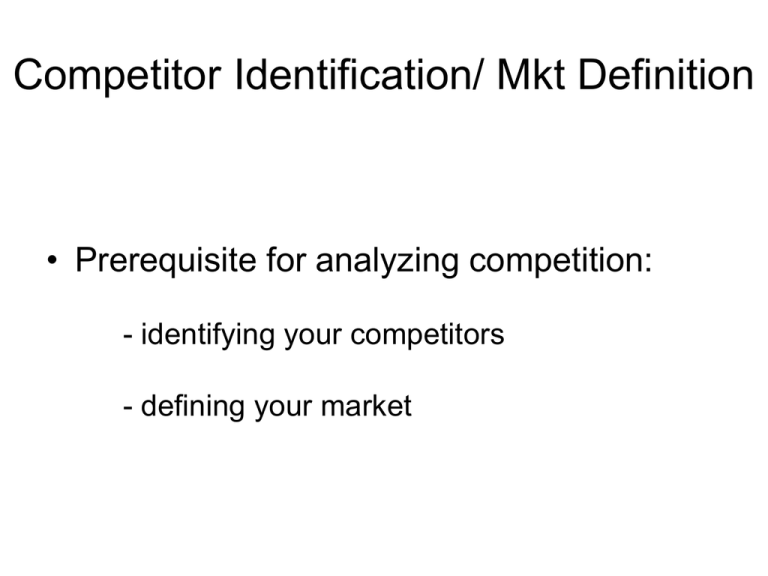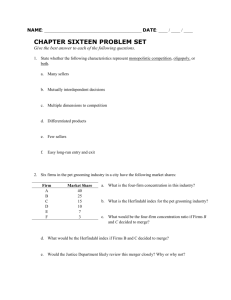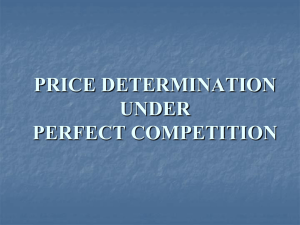Competitor Identification/ Mkt Definition
advertisement

Competitor Identification/ Mkt Definition • Prerequisite for analyzing competition: - identifying your competitors - defining your market Competitor Identification • Identifying competitors by identifying substitutes • Substitutes are products whose crossprice elasticities of demand are positive • There is a distinction between direct and indirect competitors • Similar products in different geographic markets may not be substitutes Discussion question What do you think is the Antitrust approach to market definition? Market Definition • Market definition describes the market in which a firm competes • Two firms are in the same market if they constrain each others ability to raise price • Suppose all firms collectively set prices to maximize combined profits. Would they choose to raise prices by a least 5%? Market definition • If the own-price elasticity of a group of firms collectively is small, then this group of firms constitutes a well-defined market • Antitrust agencies (Dept of Justice) looks at the above Market Structure and Competition • Market structure refers to the number and distribution of firms in a market • Common measures are N-firm concentration ratio and Herfindahl index • The Herfindahl index of an industry depends on the nature of competition in the industry A typology of competition • Perfect competition: - many sellers - homogenous products -well-informed consumers can costlessly shop around A typology of competition • Monopoly: -no competition for output • Monopolistic competition: -many sellers -each sells a differentiated product • Oligopoly: -few sellers, so the actions of one firm materially affects the others Discussion question What is more important: the attractiveness of an industry, or the position of a firm in an industry? Industry attractiveness vs firm position • Firm position is more important • What explains variation in firm profitability? Source of variation % variation explained Business-specific effects 32 Industry 19 Corporate parent 4 Year 2 • The remaining unexplained percentage is random error A Tool for Assessing Industry Attractiveness: Porter’s Five Forces Threat of new entrants Bargaining power of suppliers Rivalry among existing industry firms Threat of substitute products Bargaining power of buyers Performing the 5-forces analysis • Assess each force by asking “Is it sufficiently strong to reduce/eliminate industry profits?” • Internal rivalry -begin by defining market -price competition drives down prices -non price competition drives up costs -industry prices do not fall by themselves, so you ask “Who will reduce it and why?” Forces that drive down prices • • • • • • • • • Many sellers Stagnant or declining industry Firms have different costs Excess capacity Undifferentiated products Large/infrequent sales orders Strong exit barriers Prices/terms of sale unobservable Prices cannot be adjusted quickly Threat of new entrants • • • • • • • Entry is pervasive. Consider industry with 100 firms in 2005 Between 2005-2010, 40 new firms will enter 30-40% turnover of firms, with 12-20% of volume Entrants/exiters are smaller than estb. firms Most entrants do not survive 10yrs Entry and exit vary by industry, and are highly correlated Barriers to entry • Structural -control of essential resources -economies of scale or scope -marketing advantages of incumbency • Strategic Strategic barriers to entry • First analyze entry conditions and choose entry-deterring strategy • Entry conditions can be -Blockaded -Accommodated entry -Deterred entry Entry deterring strategies • Limit pricing -charge a low price before entry occurs • Predatory pricing -charge a low price after entry occurs • Capacity expansion Limit pricing • Incumbent sets a low price • Entrant infers that post-entry price would be low as well • And so will not enter • Is the potential entrant’s inference about postentry pricing rational? Limit pricing • Uncertainty about incumbent’s post entry price might rescue limit pricing • Uncertainty may be about -Incumbent’s objectives -Incumbent’s costs -Level of market demand • Does limit pricing really occur? Predatory pricing • Predatory firm sets a low price to drive (existing) competitors out of the market • It then recovers any losses from the low price by being a monopolist • It appears that predatory pricing is irrational in any finiteperiod interaction • Yet, firms still do it • Role of uncertainty and incumbent’s reputation for toughness in understanding paradox Capacity expansion • Do ‘large’ or ‘small’ firms have higher incentives to do it? • Is it motivated just by efficiency, or by strategic desire to gain pricing-power through preemption? Supplier power/buyer power • Upstream suppliers have power if -they are concentrated -customers have relationship specific investments -buyers do not buy large volumes -they can forward-integrate easily -they can price-discriminate • Buyer power is just flip side of the above







